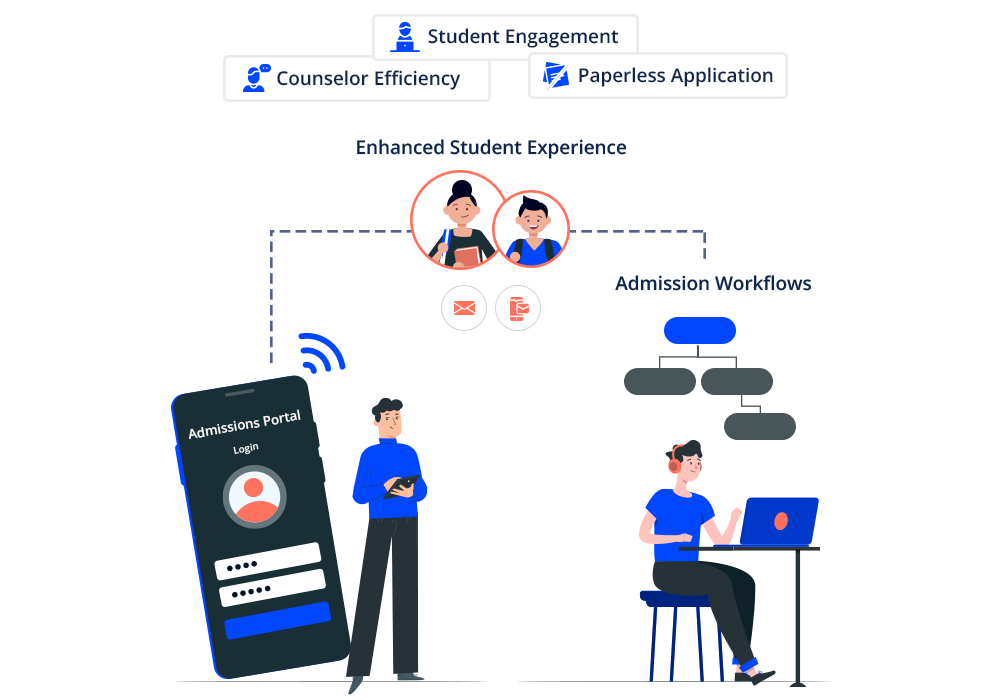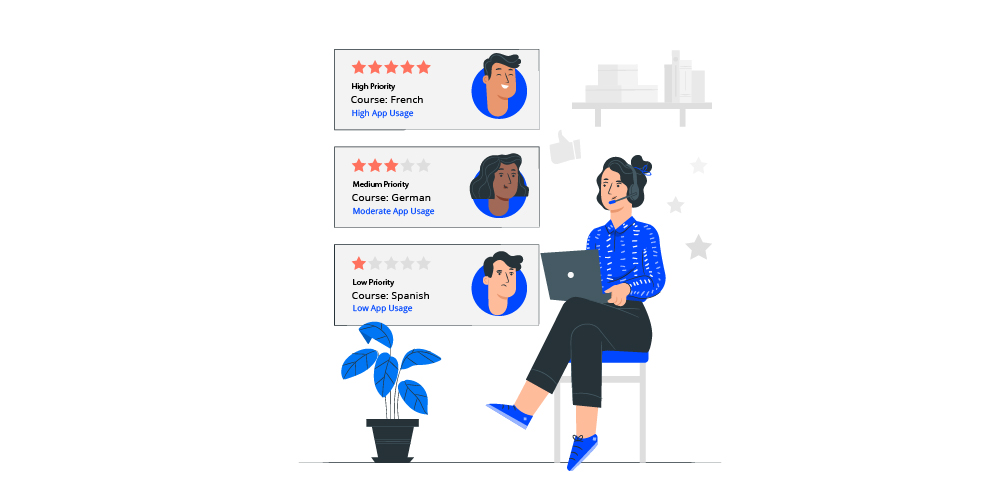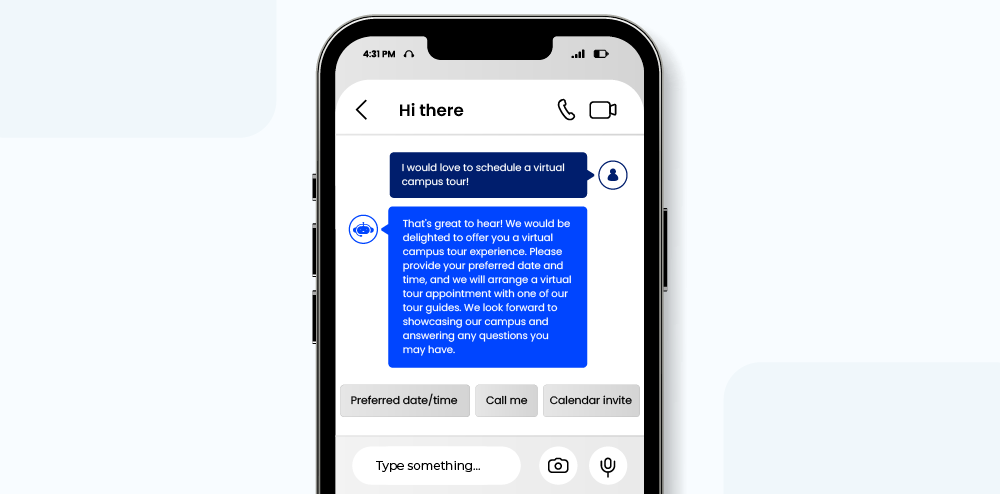The pandemic witnessed the largest and probably quickest digital transformation for most industries, especially education. 65% of the world’s population is on the internet already. And they are not afraid to use it.
This article looks at how digital transformation in education has impacted the sector—right from adopting technology in classrooms to changing the ways that students learn. The education sector is still evolving and growing, we’ll share a few trends to look forward to!
Let’s see how digital transformation impacts the education sector today.
What is Digital Transformation in Education?
Digital transformation in education enhances the experience of learners, mentors, alumni and helps in institution management of student admissions and other administrative tasks. It does so by leveraging technology to simplify business processes. It provides:
- A seamless enrollment experience for students.
- An interactive and engaging learning experience.
- Better learning outcomes.
- A flexible course structure that allows students to learn from any device, anytime.
- Improvements in how to administer student performance.
- A seamless school/college/university administration process.
Key Areas of Digital Transformation in Education
After the cold funding break in 2022 for the Edtech sector, things are looking much better in 2024. Hybrid learning has become a key trend in achieving profitability after BYJU’S took over Aakash, and the newly emerged unicorn PhysicsWallah came into the picture.
Whether it is innovative learning methods or using technology to enhance student experience, we will look at how technology helps institutions deliver better education.
1. Using Technology in the Admission Process

The admission or enrollment process is very time-consuming. Students have to stand in queues to submit their documents and admission forms. They also have to visit the institution frequently to check the status of their application. On the administration front, the admission team has to vet documents, check eligibility, shortlist students, and update them with their application status.
While the system worked until the pandemic, the new-age admission process has to be online to make things simple for everyone – parents, students, teachers, and administration. An end-to-end admission management system helps students and institutions in the following ways:
- Institutions can avoid the hassle of paperwork associated with the admission process.
- Technology can help select eligible candidates automatically.
- An automated response system can offload counselors of routine inquiries.
- Institutions can get real-time updates on the courses, faculties, students, etc.
- Students need not stand in queues and waste time checking the status of their applications.
- Students can simultaneously apply at multiple institutions without visiting the campus.
2. Managing administrative processes using technology
Technology has made it easier for institutions to manage their daily administrative processes. It can be used to manage class schedules, raise administrative requests, and store documents. Utilizing technology to manage administrative tasks improves counsellor productivity, reduces chances of human error, and builds resilient processes that don’t break down with scale.
Moving certain administrative processes online has benefitted institutions in multiple ways:
- Cloud security has improved the way documents are stored and managed.
- Timely reminders and optimized schedules have improved productivity.
- Service level agreements (SLAs) and process documentation have led to faster query resolution.
Technology has helped administrators, teachers, and counsellors focus more on their core job functions and not spend time on manual, and repetitive tasks.
3. Transforming the EdTech Models
“From a business POV, the ability to solve the doubts of learners on the platform will gain momentum. EdTech is not a substitute for the primary mode of learning. Live coaching and replicating a classroom experience have always been the motto of EdTech. Student retention rate is going to increase as coaching is an important part of the day. Post-pandemic relevance of online learning has proven the capabilities of online learning to students, parents, and educators.“
Sushob Vallan, Business Operations Manager, Unacademy
While there was a sudden influx in inquiries for online courses due to the pandemic, EdTech companies had to prepare themselves to handle both – student onboarding and coaching. EdTechs started using CRM (customer relationship management) software that is commonly used in most B2C businesses. Over the next five years, it is estimated that EdTech spending will increase by $404 billion.
Although things have gone back to normal with schools and universities reopening, we continue to witness the growth in EdTechs as they have started to adopt hybrid learning and self-paced course modules.

Here’s how online educators are using CRM:
- Student Inquiry capturing and distribution: In a digital world, student inquiries come in from several channels such as social media, website landing pages, offline campaigns, referrals, and more. Capturing the student inquiries and reaching out to them as soon as they arrive helps convert them faster. EdTech CRM helps route student inquiries to designated sales agents based on various attributes such as language spoken, location, subject, experience, etc.
- Student Intent Tracking: Knowing the students better helps the enrollment representatives pitch relevant courses. EdTech CRM captures many data points such as website visited, links clicked, time spent on each website, link, video, and more. It provides enough information to the representatives to strike an engaging conversation with students/parents.
- Lead Scoring and Prioritization: What if you could figure out the sales-ready leads and reach out to them first? EdTech CRM helps assign scores based on critical actions such as email opened, link clicked, website visited, webinar attended, and more. A lead with a higher score has a higher chance of a conversion, and your representatives can follow-up with such inquiries first to enroll them into courses.
- Data-driven Analytics: Having an overview of metrics such as daily calls made, leads from various sources, campaigns, email open and click rates, lead conversion ratio, and more helps make data-driven decisions. EdTech CRM such as LeadSquared provides over a hundred reports that make lead, enrollment, learner, and faculty tracking easy.
4. Transformation in Teaching & Learning Methodologies
The pandemic has forced educational institutions to adopt a hybrid model of imparting education, if not entirely online. The recent acquisition of Aakash by BYJU’S validates that EdTech leader sees a promising future in the hybrid-learning model.
In a conversation with TOI, “The digital transformation in education journey has been like a fast-paced time-lapse, providing a closer peek at the schools of the future. And this is not just in context to classrooms going virtual but a complete transition in the mindset, outlook, and approach to learning. With digital learning, educators are more tech-savvy to maximize engagement.” He, however, believes, “technology needs to be a teacher’s aide for learning effectiveness and not a substitute for physical schools.”
Prajodh Rajan, CoFounder and Group CEO, EuroKids International
Technology can help transform learning in the following ways:

1. Video integration for online learning:
Initially, educational institutions took to video conferencing tools such as Zoom and Google Meet to conduct classes. Institutions found themselves in a soup managing student attendance online and driving exams. However, with overnight advancements in technology, organizations can now integrate their website with such tools and recreate a seamless classroom experience digitally.
2. AR/VR-based Learning:
Augmented and Virtual reality is extensively gaining ground in education. Augmented reality is an interactive experience of a real-world environment where real-world objects are enhanced by computer-generated perceptual information. On the other hand, virtual reality is a simulation of a 3D environment which people can interact using VR glasses or headgear. These technologies make subjects like History, Geography, Biology come to life. For example, Cleveland Clinic at Case Western Reserve University trains human anatomy and surgery through AR-based 3D human models.
3. Gamification:
Games are fun. Through a gamified learning approach, educators can help students retain the subjects eidetically. Widely prevalent in K12 education, gamified learning is slowly becoming popular in professional courses and test-prep segments.
4. AI/Predictive Learning:
When you log in to your Netflix or Amazon Prime account to watch a movie or series, you see recommendations based on your likings. Organizations are leveraging similar AI technology to help recommend related topics to students. It makes classes interesting because now students can delve deeper into the courses of their interests. There have been many advancements in EduTech for years, and the pandemic has just kindled innovation.
5. Interactive Video and Media:
The concept of smart class isn’t new. Unlike blackboard learning, interactive content helps students learn by watching videos/media content. The only challenge is, how can mentors keep learners gripped amidst the distractions of digital media?
The solution lies in incorporating student engagement techniques. For instance, Google Digital, an initiative by Google in collaboration with the Indian School of Business and Ministry of Electronics and Information Technology, promotes digital awareness. Along with the interactive videos, it asks for timely responses and actions during the learning process. It helps in retaining their focus throughout the course session.
6. Smart Exam Portals:
Assessment tests and grading are also a challenge for institutions. Students sometimes try unfair means to pass the exams. To prevent this, institutions can integrate webcams on their online examination portals. It will help them track any suspicious activities such as tab opens, chatbox in the background, image exchange, and more while taking the exam.
7. Learning Experience Platform:
Think of an LXP as a mindmap of a student. Unlike a Learning Management System (LMS), which provides a one-track roadmap for learning, LXP provides autonomy. For example, an LMS offers courses in the order named 1,2,3, and so on. An LXP, on the other hand, offers curated content according to the learners’ pace and preference. An LXP provides flexibility in choosing the curriculum flow rather than following a predefined course curriculum.
In a conversation with TOI, “Online teaching has taken on a new meaning with classes becoming borderless, flexible and self-paced. Additionally, traditional classroom has undergone a massive transformation with content becoming a huge differentiator in online education- videos, quizzes, infographics, presentations, analytics, games, interactive formats have become invaluable in the curriculum. Technology in education and online learning tools have become the new chalk and board in the background of the NEP 2020.”
Dishan Kamdar, Vice-Chancellor, Flame University
5. Education chatbots to revolutionize communications

Using chatbots for education has evolved institutional communication between students and staff alike. Chatbots empowered with artificial intelligence provides an interactive experience to engage students and save time for educators.
Here’s how chatbots have become emerging allies in education:
1. Chatbot for admissions
Using chatbots to collect basic information, share and collect documents, as well as answer FAQs have proved to be a time-saving hack for administrators and faculty involved.
2. Chatbot for evaluation
By sharing test links, results, conducting quizzes, chatbots help with how students grasp a particular topic. They save time spent on creating repetitive quizzes and share insights on improving teaching or learning methods.
3. Chatbot for query resolution
Whether the query is topic-related or regarding important submission dates, education chatbots have helped institutions save costs on hiring a resource or expecting teachers to spend more time on solving these.
4. Interactive learning
Chatbots have made learning easier. From finding relevant study resources or help in writing a paper, chatbots have become a helpful tool for students to be updated in their classes.
Change is inevitable but it is also difficult to implement. Let us look at some of the challenges institutions face while transforming digitally.
Challenges in Digital Transformation in Education
Despite the pandemic forcing the adoption of various technologies, most institutions still like to depend on traditional methods of teaching. Besides opposing forces, there are also a few other challenges in transforming education.
1. Lack of a clear strategy & willingness to change
The pandemic just sent things in overdrive, and things are getting back to normal in the past 3 years. From regular physical classes getting conducted, to a slower adoption rate of technology—justifying investments in technology is proving difficult.
There is no clear strategy on how to build automated systems. It is a sector that is still driven by personnel. Lack of user-friendly systems leads to higher training costs. Administrators need third-party assistance to make changes in the processes which causes more delays.
It is important to have a strategy to introduce technology in various aspects of education—admissions, in classrooms, teacher training, etc. It should be planned in phases and have a tracking mechanism to drive better impact.
2. Insufficient tech knowledge
Teachers and administrative staff focus more on helping students. They aren’t used to complex technologies with a higher learning curve. It causes more hindrance than help.
Intuitive tools like LeadSquared with a centralized platform to set up automation and view student information, have much higher adoption rates.
Institutions need to conduct regular training programs for the staff to stay updated and know their way around a system. Here’s where partnerships with technology tools will drive higher adoption rates.
3. Dealing with system breakdowns
Institutions are heavily scrutinized on compliance and handling data in a secure manner. Technical glitches, system errors, and data leaks can prove harmful. That, combined with insufficient technical knowledge, leads to higher errors and external dependencies.
It is better to invest in technology that is stable, secure, and scalable so issues of breakdowns are identified and nullified in a timely manner.
Let’s take a look at how a leading online GMAT training institute adopted technology to improve overall student experiences.
Wizako found a dream come true platform
Wizako is a GMAT/GRE test-prep platform that has been serving students for 20+ years. They provide live online as well as offline courses to aspiring students.
“LeadSquared, as a platform, is a dream come true. The team envisions the problems we face and provides end-to-end solutions that significantly improve the efficiency of my teams.”
K S Baskar, Founder and CEO, Wizako
The team was maintaining the progress for each student and enrollments manually. They faced an issue when counselors and marketers were managing the student database through different platforms, such as email and WhatsApp.
After implementing LeadSquared, they experienced a remarkable change in how students were served. This resulted in –
- Significant improvement in team productivity
- One shot view of all incoming leads
- Ability to build student journey maps
- Customize the platform based on their needs
The bottom line
It has been a challenging journey for the traditional learning system. Brick and mortar training institutes, schools, and colleges have been forced to implement digital learning modules. Digitization in education has helped the learners as well as teachers to a great extent.
However, the challenges remain in online learning and teaching. For instance, educators have not been able to measure the learning outcomes from online education accurately. Moreover, learners who do not have access to the internet, or lack smartphones/laptops, are still deprived of education.
Thus, a hybrid mix of digital and traditional learning is a way forward until digital education becomes accessible to all.
“Although penetrating the global market is important, there is a priority on a more serious issue. It is important to build a proactive solution, especially to support the students who cannot afford laptops and mobile phones. There are many challenges which Cuemath, a pioneer in offline turned online education, is planning to curb. Collaborating with schools, colleges and adopting a hybrid model is very much a possibility. Once the tech-to-all issue is solved, the adoption will increase, and this will lead to an enhanced student experience.”
Saurabh Acharya, Group product manager, Cuemath
LeadSquared helps educational institutions, training centers, and EdTechs transform their admission process. With a strong clientele of over 600+ organizations, including top online and offline education providers such as BYJU’S, Vedantu, Cuemath, Unacademy, Amity University, Manipal University, and more, we can assist you in your digital transformation journey.
FAQs
The three major areas of digital transformation in education include using technology to improve admission rates, adopting new methods of teaching & learning methods, and simplifying administrative tasks through technology.
Digital transformation in education will provide –
1. A seamless enrollment experience for students
2. An interactive and engaging learning experience
3. Better learning outcomes
4. A flexible course structure and allow students to learn from any device, anytime.
5. Improvements on how to administer student performance
6. A seamless school/college/university administration process
Having recovered from the pandemic, most institutions are more likely to go to traditional ways of teaching. The reason? – Institutions didn’t have clear digitization strategy, lack tech knowledge among staff, and faced system breakdowns & data leaks.
To overcome these challenges, institutions need technology, which is stable, easy-to-use, and compliant to ensure higher returns and adoption rates.







